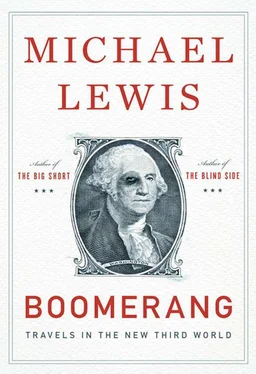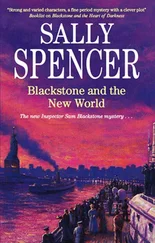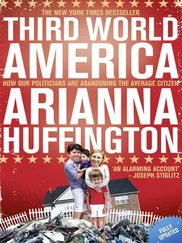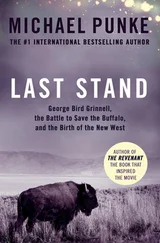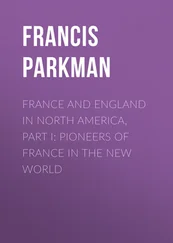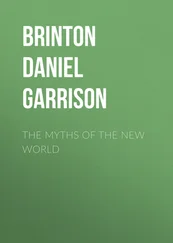A week later the Irish Finance Ministry hired investment bankers from Merrill Lynch to advise them. Some might say that if you were asking Merrill Lynch for financial advice in 2008 you were already in trouble, but that is not entirely fair. The bank analyst who had been most prescient and interesting about the Irish banks worked for Merrill Lynch. His name was Philip Ingram. In his late twenties, and a bit quirky—at Cambridge University he’d prepared for a career in zoology—Ingram had done something original and useful. He’d shined a new light on the way Irish banks lent against commercial real estate.
The commercial real estate loan market is generally less transparent than the market for home loans. The deals between bankers and property developers are one-off, on terms unknown to all but a few insiders. The parties to any loan always claim it is prudent: a bank analyst has little choice but to take them at their word. But Ingram was skeptical of the Irish banks. He had read Morgan Kelly’s newspaper articles and even paid Kelly a visit in his University College office. To Ingram’s eyes there appeared to be a vast difference between what the Irish banks were saying and what they were doing. To get at it he ignored what they were saying and went looking for knowledgeable insiders in the commercial property market. He interviewed them, as a journalist might. On March 13, 2008, six months before the Irish real estate Ponzi scheme collapsed, Ingram published a report in which he simply quoted verbatim what market insiders had told him about various banks’ lending to commercial real estate developers. The Irish banks were making far riskier loans in Ireland than they were in Britain, but even in Britain, the report revealed, they were the nuttiest lenders around: in that category, Anglo Irish, Bank of Ireland, and AIB came, in that order, first, second, and third.
FOR A FEW hours the Merrill Lynch report was the hottest read in the London financial markets, until Merrill Lynch retracted it. Merrill was the lead underwriter of Anglo Irish’s bonds and the corporate broker to AIB: they’d earned huge sums of money off the growth of Irish banking. Moments after Phil Ingram hit the Send button on his report, the banks called their Merrill Lynch bankers and threatened to take their business elsewhere. The same executive from Anglo Irish Bank who had called to scream at Morgan Kelly called a Merrill research analyst to scream some more. (“I thought your work was fucking shit!”) Ingram’s superiors at Merrill Lynch hauled him into meetings with in-house lawyers who rewrote his report, purging it of its pointed language and its damning quotes from market insiders, including their many references to Irish banks. Ingram’s immediate boss in the research department, a fellow named Ed Allchin, was made to apologize to Merrill’s investment bankers individually for the trouble he’d caused them. And from that moment everything Ingram wrote about Irish banks was rewritten and bowdlerized by Merrill Lynch’s lawyers. At the end of 2008 Merrill fired him.
It would have been difficult for Merrill Lynch’s investment bankers not to know, on some level, that, in a reckless market, the Irish banks acted with a recklessness all their own. But in the six-page memo to Brian Lenihan—for which the Irish taxpayer forked over to Merrill Lynch 7 million euros—they kept whatever reservations they might have had to themselves. “All of the Irish banks are profitable and well-capitalized,” wrote the Merrill Lynch advisers, and then went on to suggest that their problem wasn’t at all the bad loans they had made but the panic in the market. The Merrill Lynch memo listed a number of possible responses the Irish government might have to any run on Irish banks. It refrained from explicitly recommending one course of action over another, but its analysis of the problem implied that the most sensible thing to do was to guarantee the banks. After all, the banks were “fundamentally sound.” Promise to eat all losses, and markets would quickly settle down—and the Irish banks would go back to being in perfectly good shape. As there would be no losses, the promise would be free.
What exactly was said in the meeting on the night of September 29, 2008, remains, amazingly, something of a secret. The government has refused Freedom of Information Act requests for the notes taken by participants. Apart from the prime minister and the bank regulators, the only people at the conference table inside the Ministry of Finance were the heads of the two yet-to-be disgraced big Irish banks: AIB and Bank of Ireland. Evidently they either lied to Brian Lenihan about the extent of their losses or didn’t know themselves what those were. Or both. “At the time they were all saying the same thing,” an Irish bank analyst tells me. “‘We don’t have any subprime.’” What they meant was that they had avoided lending to American subprime borrowers; what they neglected to mention was that, in the general frenzy, all of Ireland had become subprime. Otherwise sound Irish borrowers had been rendered unsound by the size of the loans they had taken out to buy inflated Irish property. That had been the strangest consequence of the Irish bubble: to throw a nation that had finally clawed its way of out centuries of indentured servitude back into indentured servitude.
The report from Merrill Lynch asserting that the banks were “fundamentally sound” buttressed whatever story the banks told the finance minister. The Irish government’s bank regulator, Patrick Neary, had echoed Merrill’s judgment. Morgan Kelly was still a zany egghead; at any rate, no one who took him seriously was present in the room. Anglo Irish’s stock had fallen 46 percent that day; AIB’s had fallen 15 percent; there was a fair chance that when the stock exchange reopened one or both of them would go out of business. In the general panic, absent government intervention, the other banks would have gone down with Anglo Irish. Lenihan faced a choice: Should he believe the people immediately around him or the financial markets? Should he trust the family or the experts? He stuck with the family. Ireland gave its promise. And the promise sank Ireland.
EVEN AT THE time, the decision seemed a bit odd. The Irish banks, like the big American banks, managed to persuade a lot of people that they were so intertwined with their economy that their failure would bring down a lot of other things, too. But they weren’t, at least not all of them. Anglo Irish Bank had only six branches, no ATMs, and no organic relationship with Irish business except the property developers. It lent money to people to buy land and build: that’s all it did. It did this with money it had borrowed from foreigners. It was not, by nature, systemic. It became so only when its losses were made everyone’s.
In any case, if the Irish wanted to save their banks, why not guarantee just the deposits? There’s a big difference between depositors and bondholders: depositors can flee. The immediate danger to the banks was that savers who had put money into them would take their money out, and the banks would be without funds. The investors who owned the roughly 80 billion euros’ worth of Irish bank bonds, on the other hand, were stuck. They couldn’t take their money out of the bank. And their 80 billion euros very nearly exactly covered the eventual losses inside the Irish banks. These private bondholders didn’t have any right to be made whole by the Irish government. The bondholders didn’t even expect to be made whole by the Irish government. Not long ago I spoke with a former senior Merrill Lynch bond trader who, on September 29, 2008, owned a pile of bonds in one of the Irish banks. He’d already tried to sell them back to the bank for 50 cents on the dollar—that is, he’d offered to take a huge loss, just to get out of them. On the morning of September 30 he awakened to find his bonds worth 100 cents on the dollar. The Irish government had guaranteed them! He couldn’t believe his luck.
Читать дальше
